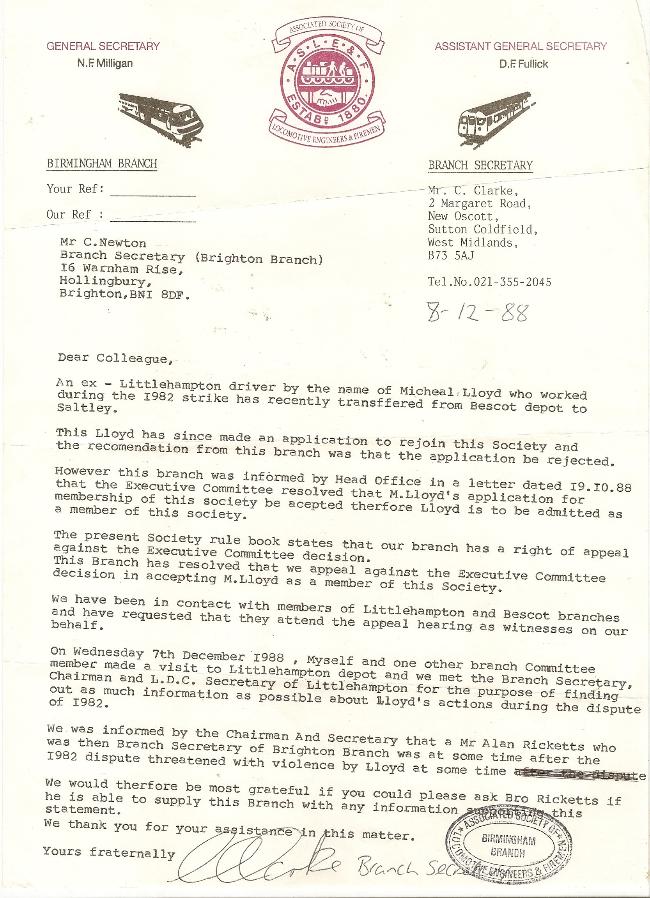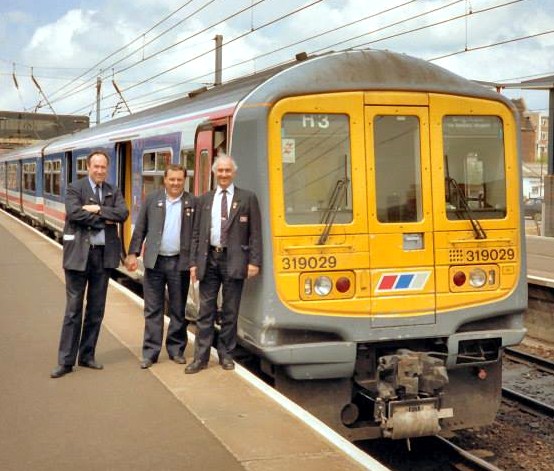
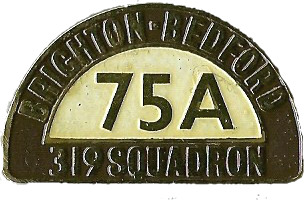
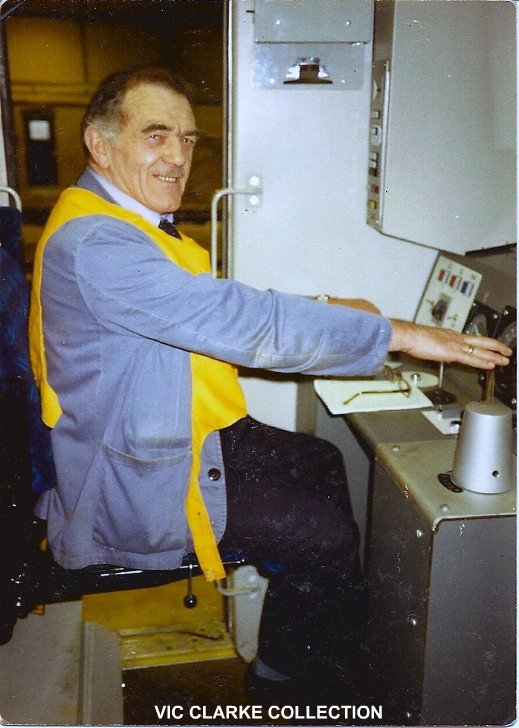
The 319’s when new were a nightmare and just used to drop dead without any warning and recalls retired driver Ted Janes. He also recalls remember several occasions on arriving for routes at St Pancras finding not one 319 was running, on one occasion that this happened Ozzy (Laurie Osman), Harry Mitchell and Ted pissed off and enjoyed a day at Hendon RAF Museum instead.
DAVID TIMOTHY COLLECTION
BRIGHTON DRIVERS MICK PULLINGER, VIC SEXTON & GERRY AGGETT
319's started arriving in early 1988 and I'm amazed they lasted as long as they have, by the way when we were running guards training trips to London Bridge we used to get messages for a New Cross taxi firm over the radio, evidently we were tuned into their frequency and god knows what they thought if they received any of our messages.
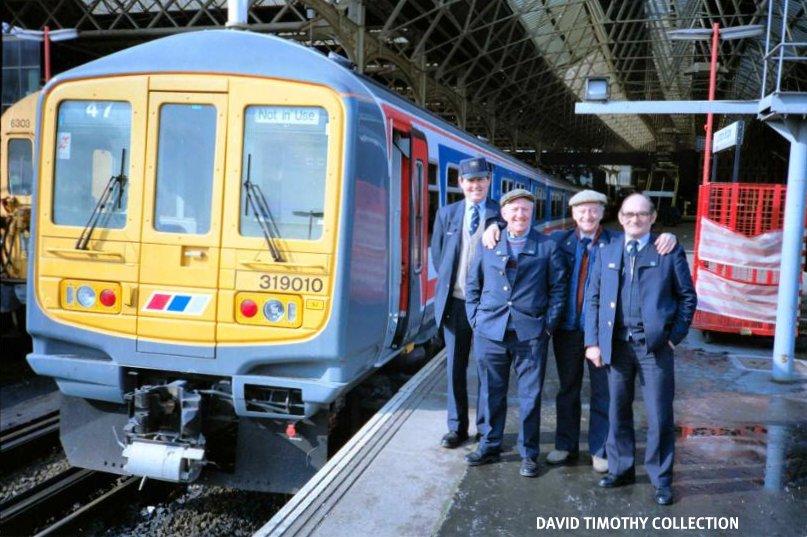
Left ~ Right: Brighton ‘Tricky Link’ Drivers
Ron French, Bill Lipscombe, Les Smith & Freddie Bell
On training trips between Brighton and London Bridge
On another occasion I had to assist a 317 which had come to greif at Flitwick, neither off us had a clue how to get out of the predicament so we agreed as he had his own brake I would just shove him to Bedford so that's what we did! I had to come back pass and just caught the midnight from Vic.
Bernie Haynes had a pan go up coming down through Streatham on the overnight empties to Bedford and hit a bridge and I had one go up in platform four at Brighton minding my own business waiting to go to "the Walk" and also had one shut down cruising past Bedford home signal, that turned out to be the carbon on the pickup had disintegrated.
Courtsey of Ted Janes
DRIVER
BRIGHTON

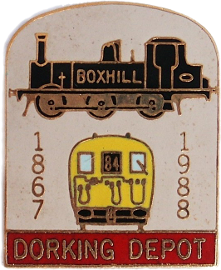
BRIGHTON No. 1 & 2 BRANCHES
THE AMALGAMATION OF THE TWO BRANCHES
On the 9th of March 1988 a special joint branch meeting was held to dissolve the Brighton No. 1 (A.S.L.E.&F. Branch No.34 (Locomotive Drivers and Secondmen.) and Brighton No. 2 (A.S.L.E.&F. Branch No.35 (Electric Multiple Unit Drivers Brighton & West Worthing depots) branches and to once again form one A.S.L.E.&F. Branch for Brighton. This came about as a direct result of the rationalisation of the two Motive Power depots by British Rail. At this Special branch meeting, the creation of a new Branch was formed and to be known as the Brighton Branch (A.S.L.E.&F. Branch No.35). It was decided that all branch officers would have to be re-elected. Both of the existing branch secretaries Bro T. Fielding of No.1 & Bro. A. Ricketts of No. 2, had both decided not to re-stand for their old positions. Therefore a new branch secretary was sort after and this position was taken up by Bro C. Newton.
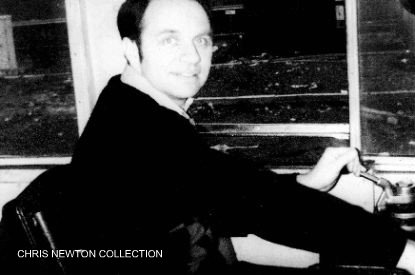
Chris Newton
Brighton Secretary 1988 - 2000.
With the two depots being amalgamated this brought together 153 drivers and the various training problems that were caused through this rationalisation programme. The Mixed Traction had 51 drivers and the E.M.U.T. had 102 drivers.
This was caused by having to amalgamate the driver’s seniorities from both depots and
placing the drivers into their correct link positions. The route knowledge at Brighton spanned
along the coast from Ore in the East to Salisbury in the West, far North as Bedford and to
Reading via Guildford and via Kensington and the Great Western main line.
All the Mixed Traction drivers had to learn the various forms of electrical multiple units.
Whilst a number of E.M.U.T. drivers had to learn the new 319 and the Thameslink route,
many also had to learn the various types of diesels and the associated routes as well. The new
Mixed Traction depot was to be made up of the following links sizes.
Link one would consist of 32 drivers which worked on all forms of traction and over all
routes.
Since the beginning of the Railways Enginemen have always regarded “seniority” as the
deciding factor as to what work they did. The more seniority you had gained as a Fireman and then Engineman the better and more varied work you would do.
This work has always been divided at Depots by means of men being grouped together in “Links” and progressing from the bottom Link with the most menial work to finally reaching the Top Link doing the most prestige and best paying work.
Motormen Depots on the South Coast did not operate this system and all Motormen would be in one Link doing the same work.
Link two would also consist of 32 drivers working on all forms of traction covering most of routes that was covered in the top link. Both of the top two links where made up of both M.T. & E.M.U.T. drivers with the driver’s seniority dictation which link a driver would be placed in.
The L211 link consists of the senior 24 E.M.U.T. drivers of which 22 where protected under the L211 agreement and a further 2 senior drivers. The additional 2 where do to retire at a similar time as the rest of the L211 drivers.
The fourth link was made up of three senior E.M.U.T, drivers who did not want to learn any
further routes or traction and the junior drivers from both depots. These drivers only worked
over the routes that the old E.M.U.T. depot worked over. The exception to this was the former M.T. drivers who still retained their route and traction as well as learning this links route and traction.
The allocated link was a eight manned link, that worked in and out of Brighton Lovers Walk
Maintenance Depot and round the triangle Brighton/Hove/Preston Park/Brighton which also
included the appropriate sidings and yards.
The restricted link was of 4 Drivers who only worked within the confines of Lovers Walk
Maintenance depot.
The smallest link was a 3 manned station pilot link that operated to the same criteria as the
allocated link.
There were 51 drivers requiring to be trained on E.M.U.T. traction and routes. In the top two
links 24 E.M.U.T. drivers had to learn all forms of diesels and the associated routes and
yards.
These figures where constantly going to change over the coming months as drivers retired
and drivers moved from the other junior links and taking up their rightful seniority position
within the depot.
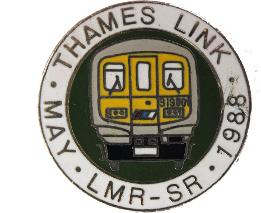
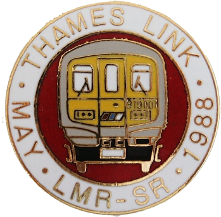
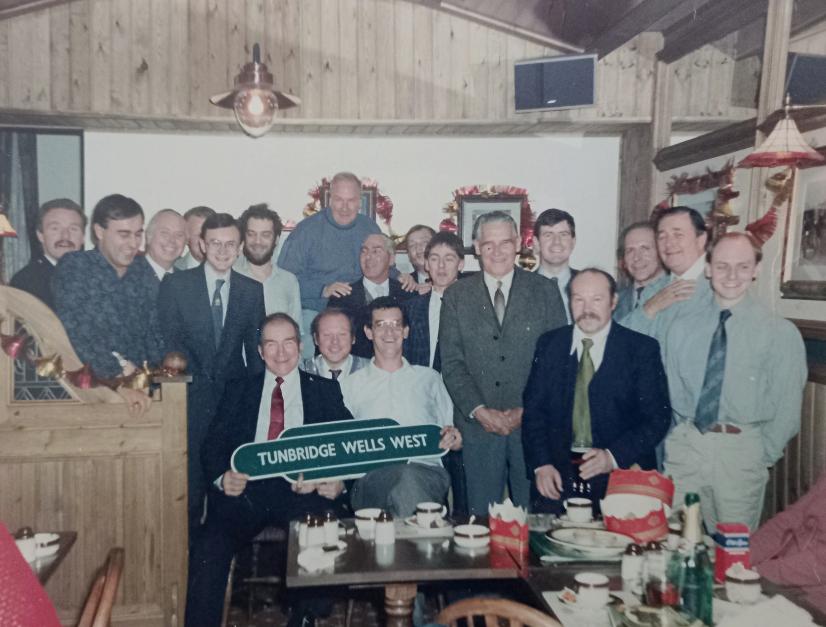
IAIN BOND COLLECTION
Tunbridge Wells West Reunion 1988
Back Row L - R Unknown 1, Unknown 2, Vic Hodges Guard, Unknown 3,
Chris Wheeler Guard, Gerry Ellard Driver, Arthur Ashdown Driver, Don Thake Guard, Unknown 4, Mark Thake Guard, Unknown 5, Chris Exley Driver, Unknown 6, Unknown 7,
Front Unknown 8, John Carney Driver, Unknown 9, Rodney Simpson Driver, & Unknown 10
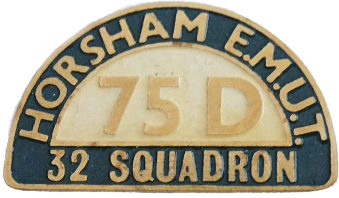
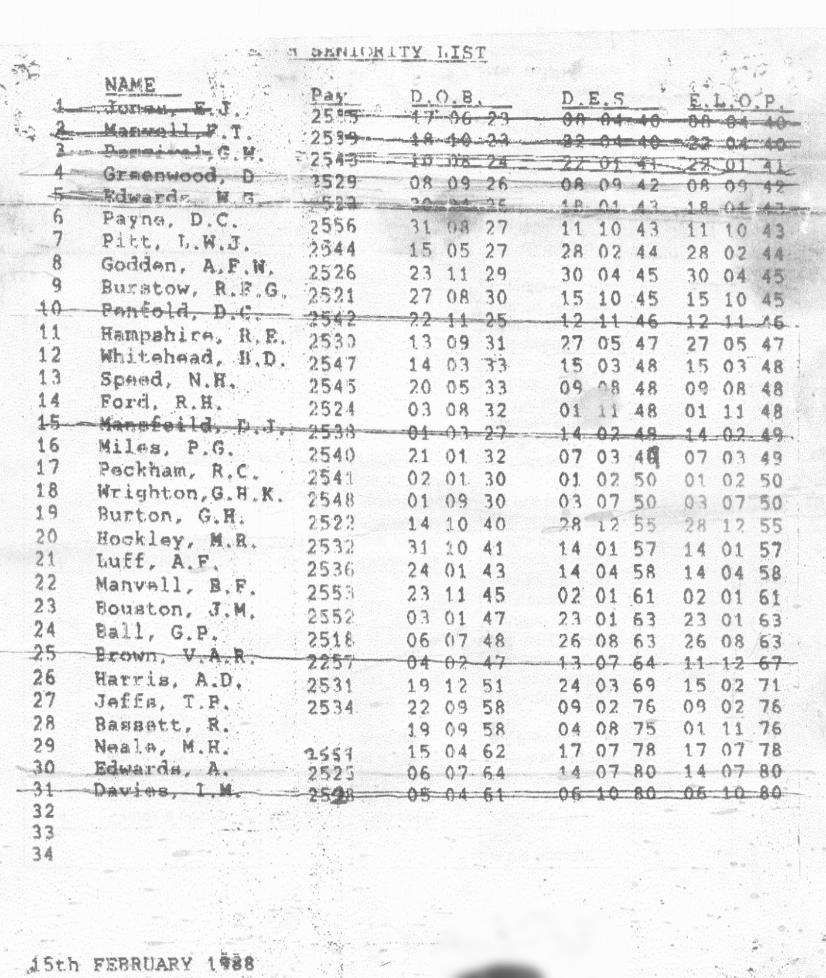
Horsham E.M.U.T. Seniority list February 1988
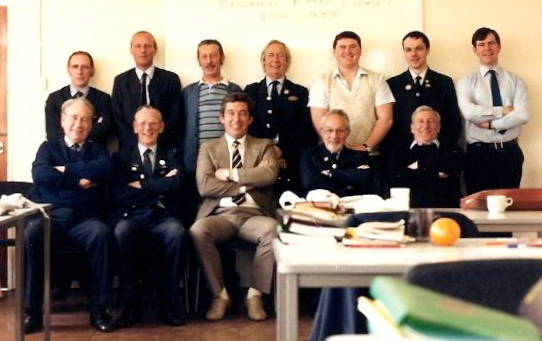
CHRIS EXLEY COLLECTION
Back Row Left - Right: Dave Pumfrey, Dickie Potts, Johnny Saunders, Peter Mantell,
Unknown. & Chris Exley
Front Row: Left - Right: Ernie Meeds, Alan Hardiman, Mick Bassett (Chief Traction
Inspector, Peter Staniford & Brian Young
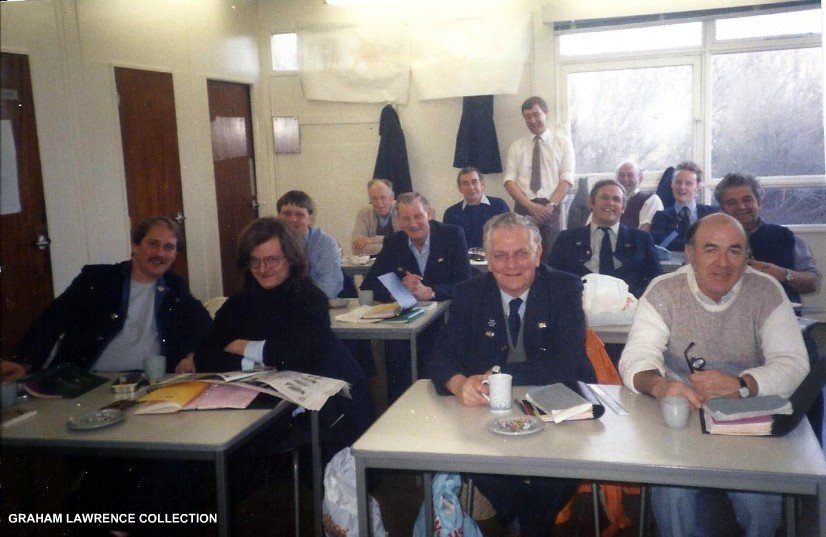
Front Row L~ R: Russel Dare (Bognor (O.O.C.), Neal Cowdrey, Roy Swetman
& Freddie Goff.
Middle Row L~R: John Lucas (Norwood), Bill Lawrence, Bernie Hayne & Ron Rabbetts
Back Row L~R: Alfie Pelling, Peter Gambling, Brian Hobby (Instructor), Reg Jarrett
& Mick Neale (Horsham & Immingham)
LOCOMOTIVE JOURNAL
APRIL 1988
What the member of A.S.L.E.F wish to know is should an accident happen when a driver is acting as a “minder driver”, wo will stand before the Court? : the driver the BRB don’t trust to drive the train driver being paid £1.70p per turn to mind the inadequately trained driver?
All drivers know that when a driver is in full command of an efficient continuous brake, to bring a train smoothly to a stand within signals or platform limits is a feat which calls for very considerable skill.
There are so many variable facts involved: the speed and the weight of the training the condition of the running line.
Mistakes can be made.
Furthermore, should the mistake happen when the train is running up to danger signals, a permanent speed, etc., or into a terminus station the consequences could be fatal.
The £1.70p per turn which the BRB proposed to the sought after minder drivers cannot buy a good life cover policy.
I therefore, ask all “old deal” drivers and also the EC to think more deeply about what I have written. And please don’t be taken in by the BRB propaganda.
GEORGE E. CAULFIELD
EASTBOURNE BRANCH
LOCOMOTIVE JOURNAL
APRIL 1988
TIME TO FIGHT ON TRAINCREW
In an article on RSNT Decision 92 and the Traincrew Concept I finished my contribution by warning that we should all prepare for a future stand by foregoing the new television or holiday, for it was obvious that we should soon have to fight or capitulate as a union.
Well brothers and sisters, the time has arrived. The proposals before the EC on the review of the Negotiating and Consultative Procedures are potentially the most damaging ever entered into the Machinery.
What the Board wants is the end of any meaningful representation at LDC and Sectional Council level, and a national negotiation team ultimately bound bt arbitrary decisions. At local and council level we will be talking shop frustrated by a management that will implement decisions after 14 days, and an EC operating in the sure knowledge that RSNT decisions have rarely favoured the union’s cause.
We must now ensure the our union fights these proposals with every mean at it disposal, for we must not allow the Executive to operate as they did with decision 92. Our leaders told us while we were protesting on the Southern that we were not reflecting the majority view.
This was not borne out at the 1987 AAD when conference made it very clear what they thought of the executive’s handling of the case, and demanded a recall AAD before they would allow a signing of the Traincrew Concept. The delegates were very concerned with many aspects, not least the very proposals before us, that’s why they wanted a recall.
All the BRB has done is to separate the machinery of negotiation proposals from the Traincrew Concept proposals with the hope of steamrolling it through. Surely we are on to this tactic aren’t we? Surely we read the Monopolies Commission’s report.
My fear is that to sign the Traincrew proposals would be to throw away a weapon with which we can fight the Machinery of Negotiation proposals. We should refuse to sign any Traincrew deal until the contentious Machinery of Negotiation proposals are removed from the table.
The Board has always known that the strength of our union lies in the quality of its representatives at local and sectional level. It is these people who, from the sterling work of everyday trade union operation glean the experience to represent at the very top.
Cut these arteries and the head will die.
The board will first try to undermine us by going above the reps direct to the membership to con them into thinking they don’t need reps, for they are such good “chaps” they will look after their interests.
Well don’t fall for that one. These are the “chaps” who would have sacked you in 1982, and redeploy some only with loss of pension. These “chaps” are not like the old managers who mostly came through the ranks and knew the industry from both sides of the track, these come from university and are trained in purely in the techniques of management and know little about railways.
These techniques have to be seen to be believed. Absolute management power is the order of the day so should we be surprised when er are faced wit the “Implementation syndrome” ?
We have got to shake ourselves free of the ghost of ’82. We regain our pride only when we say “...... enough”.
The way forward doesn’t necessarily mean strikes, but it does mean that we are a body of people that will not be manipulated in the cause of dogma that wishes to remove all power from the unions and thus you.
LEN WORBOYS
LDC SECRETARY
FRATTON
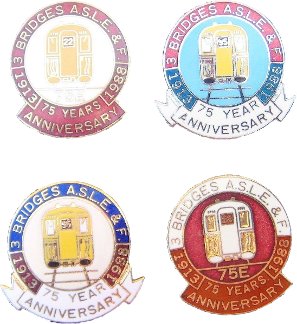
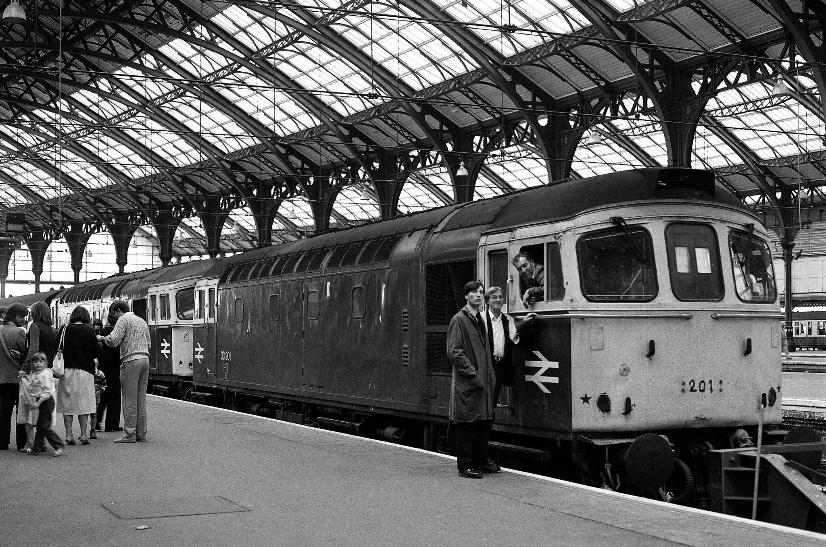
Left - Right Brighton Passed Man Brian Overton, Unknown and Driver Harry Woolacott
BRIGHTON
SPECIAL BRANCH MEETING
HELD ON April 21st 1988 AT 11:00 &
Number of member present, a total of 53 members a list had compiled and has been enclosed.
Both meetings were opened by the Chairman Bro. W. Mackenzie who explained the reason
for calling these meetings, by explaining there was no branch meetings for April owing to the
merger of No.1 & No.2 Branches and to hear the men’s grievances and up date the position as
to Managements position.
First the “Reading Work” this was explained and that there was still a good chance of
retaining the work as the matter being perused by the General Manager.
Secondly, complaints about the list clerk, it was pointed out that management have been told
of the problems caused by Mr. Ken Smith not working to the agreed minutes as drawn up
both management and L.D.C.’S Thameslink service.
Sunday situation has been explained and should resolve itself.
Training Courses
Position of 47 class explained that a course of 3 Brighton men on June 6th and that no more
course date were known, and that men in the L211 link opting out would not take preference
over men in the other links.
Secondly, complaints about the list clerk, it was pointed out that management have been told
of the problems caused by Mr. Ken Smith not working to the agreed minutes as drawn up
both management and L.D.C.’S Thameslink service.
Sunday situation has been explained and should resolve itself.
Training Courses Position of 47 class explained that a course of 3 Brighton men on June 6th
and that no more course date were known, and that men in the L211 link opting out would
not take preference over men in the other links.
Chairman gave a breakdown of mileage and D.O.O.Weekday 12 x Mileage/D.O.O. 7 x 319
Duty, 5 x E.M.U.T.Saturday 16 Mileage duties, Sunday 7 duties and there is 78 instance of
D.O.O against 19 at present.
Two resolutions were then put before the meeting. Proposed A. Ricketts & Seconded E.
Janes. “That this ASLE&F Branch (Brighton M.T.) instructs its L.D.C.’s to progress the
grievances expressed at the two meetings held on Thursday 21.4.88 with Management
as a matter of great urgency, and in the event of these problems not being resolved to this
Branches satisfaction, a withdrawal of co-operation will be implement.” Voted: Unanimously
by all the members.Resolution, “That this Branch wishes to pass a vote of no confidence in
the List Clerk Mr. Ken Smith.” Proposed G. Hatcher & Seconded by P. Edwards. Voted:
Unanimously by all the members.
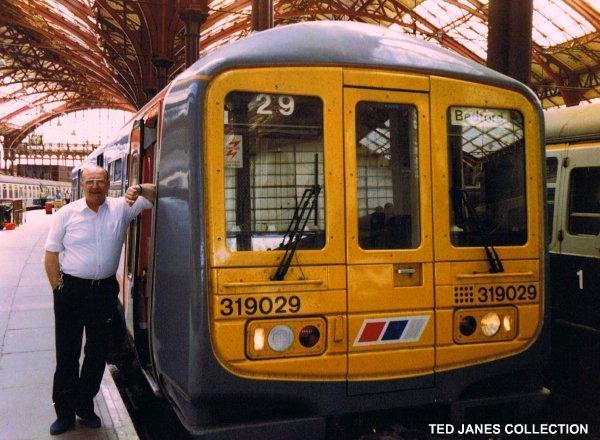
Brighton Driver Ted Janes
Ted remembers on one occasion going on to the way back from Bedford, at Coulsdon South and after a lot of getting ready to assist I said to the guard of the train when we arrive at Merstham don't put your key in or you'll blow the lot again, off we went and stopped at Merstam and wallop the bloody lot tripped out, the prat of a guard ignored my advice and we were f****d. Ted went back though the train resetting what had tripped and said to one passenger excuse me Sir but I have to get to the cupboard behind you, you don't happen to hold shares in G.E.C. do you? and his reply was not bloody likely and if I had they would be sold in the morning.
Another regular trick of these bloody terrible units was to lose the control circuit when an approaching express rattled the sliding doors with enough force to open them slightly. On the 07:09 to Bedford we used to very often pass a 47 headed express at Radlett Junction doing about 90 after chasing downhill from St Albans and if you met him in the wrong spot on went the brakes.
ADRIAN BACKSHALL COLLECTION
Brighton driver Graham Postance’s infamous derailment at Copyhold Junction 14th June, 1988, involving the unloaded stone train returning back from Ardingly stone plant. The train was being worked by a class 56 locomotive, No. 56064.
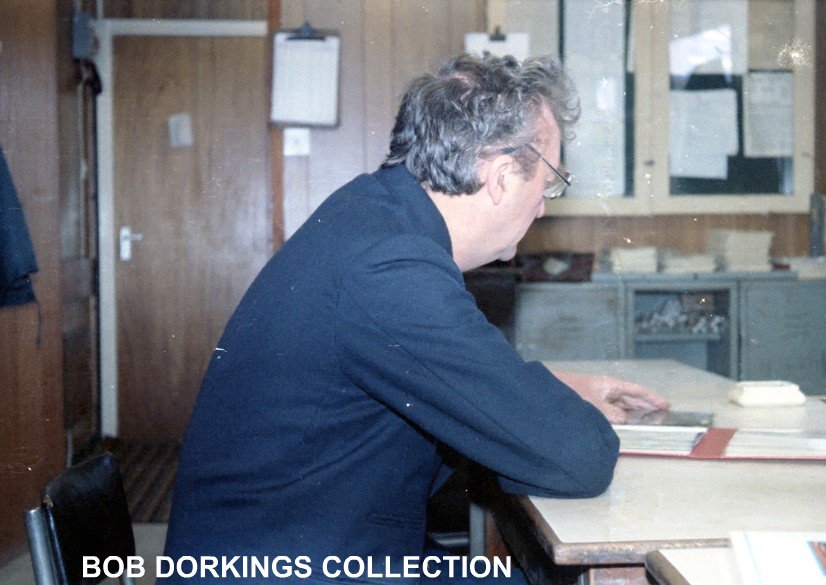
Littlehampton Driver Peter Judge
LOCOMOTIVE JOURNAL
OCTOBER 1988
NORWOOD
NO ONE THERE
On 2 August 1988, I was unfortunate enough to witness a passenger being attacked on the down platform at New Cross station. As I was on the up side a fair distance from the incident. I decided that the best assistance that I could render would be to call for the Police.
I ran to the nearest telephone that I could think of which was at the ticket barrier (BR Auto Circuit) and rang 111. The operator replied and asked which service I required and I asked for Police. Firstly they were engaged, and when eventually I got the ringing tome I still had not received a response after approximately 3 minutes.
At this point I gave up and in despair went in search of a public telephone. I m pleased to say my 999 call achieved the response I had expected from utilising the BR 111 number.
The precious minutes lost could well have resulted in a fellow human being sustaining very serious injury. I wish to express my frustration and dismay at a system which, although designed to be called upon in a situation such as I experienced, clearly failed to deliver.
The unfortunate person involved in the attack could quite easily have been you or I and, therefore, I feel that procedures for dealing with emergencies of this type are woefully inadequate and need looking into
M. BLIZZARD
DRIVER
NORWOOD
On the Sunday 2nd October 1988, the grade of driver’s assistant was abolished and replaced with the train(wo)man concept. This signalled the end, as those within the grade passed on to drivers, of the second man in the cab. A feature that had existed, in one form or another, for the previous 160 years.
It should be remembered that the ancestry lineage of the role began with fireman, until 1968, then second man, and, finally, ending with the driver’s assistant, although most of us still used the term second man until the very end.
British Rail had proposals to end the second man role, and introduce the train man, as early as 1969. With the end of steam, and no longer the need for a fireman, British Rail had plans to implement single manning as soon possible. But their modernisation plans, in the late 1950s and early 1960s, were thwarted because they introduced main line diesel locomotives, with a heating method which was predominantly steam, which required a boiler, operated by a second man.
DRIVER ONLY BOILER OPERATION
British Rail management did try a system of Driver- Only Boiler Operation, which entailed the boiler being prepared on the depot by maintenance staff. On/Off buttons fitted to some, predominantly Class 47, locomotives were operated by the driver when coupled or uncoupled to the coaching stock. Boiler reliability issues, and protests from our union, protecting jobs, saw this system abandoned. Thus the second man was employed in steam heating operations right up to the 1980s although, by the middle of that decade, steam heating had been virtually phased out.
Electric main line traction with an electric train heat supply was, however, altogether different. With this traction, like the numerous suburban lines operated by both electric and diesel multiple units, single-manned for many years, a second man was not required.
The first phase came in 1965 with an easing of manning agreement which allowed a substantial increase in single-manned main line operation. Our union fought to protect, and did indeed achieve protection of, firemen’s earnings.
Double manning also continued on numerous types of work that required a second man, including light engine movements, ferrying, trip work, and ballast turns. In addition, manning agreements still in place required a driver to be rostered a second man if on a turn in excess of eight hours or with no clear rostered physical needs break.
PROGRESSION TO DRIVER
Progression to driver, of course, was still the ultimate aim of the second man with traction; rules and regulations learnt on the job and by attending, in your own time, mutual improvement classes. A more formal method of training commenced in 1976 with the introduction of the MP12 driver’s course, 26 weeks long, in three parts, comprising rules, traction and train handling. A second man was eligible to commence a course when 20 years and 6 months old and it was, according to his seniority, his turn. The 1970s saw a huge recruitment drive as British Rail looked ahead at a large retirement profile fuelled by an ageing driver work force.
Some of the remaining second men were made to undertake guards’ training as their workload disappeared and, by the early 1990s, the driver’s assistant was consigned to history.
FROM THE BACK TO FRONT DRIVERS
On Monday 3rd, October, 1988, “The Traincrew Concept” a new line of promotion to the
Driver’s grade was brought into use. This did away with the traditional line of promotion within the Motive Power grades. The Secondman’s grade was now to be known as a Trainman (D) mixing Secondman’s work with freight guard’s work and making the position more versatile. Trainman (D) where now being recruited up to the age of 45, rather than the previous age of 25. A new aptitude test was now being introduced to enable the railway company to recruit the right type of person to become a Driver. All eligible guards who were under the age of 45 would be allowed to apply to become a Driver subject to them passing this new test. Those successful enough would have a common seniority date (03.10.88) with the guard’s seniority date being the deciding factor.
All the Brighton secondmen were soon to be promoted to Driver. A number of Brighton
guards found themselves moving to the London area depots to get their promotion to Driving
jobs quicker rather than waiting for a vacancy to become available at Brighton at the time
there was little chance of getting a Drivers job at Brighton due to loss of work and also the
amalgamation of the two depots.
Just as with the end of Steam those who moved away for their promotion now found
themselves away from Brighton for at least four years or more. This was due to at least
twelve months driver training followed by having to now complete three years productive work at their depot before they where eligible to register their move back to Brighton. Whilst those Drivers who moved away to get promotion found that during their required three years
productive work vacancies started to appear at Brighton due to retirements allowing other
guards/trainmen to get their promotion to Drivers at Brighton.
Also during the early - mid 1990’s mass retirements started to take place with the old steam
Drivers and Motormen reaching retirement age. The turn over of Drivers at Brighton and
throughout the railway network at this time was massive and Driver shortage was common
practice. This was due to the industry failing to recruit and retain footplate staff over many
years (This will be repeated within the railway industry in about 2020).
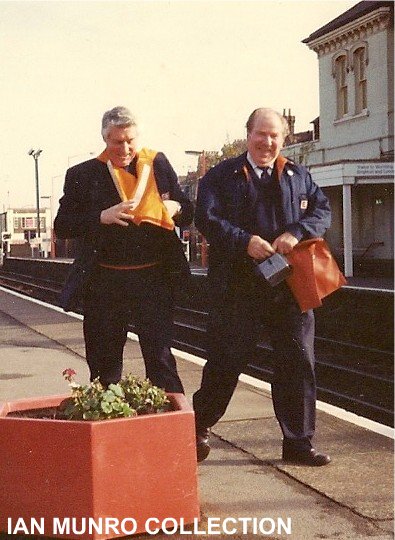
West Worthing Drivers Frank Geal & Ken Pursley
